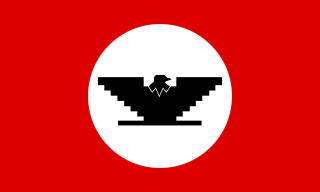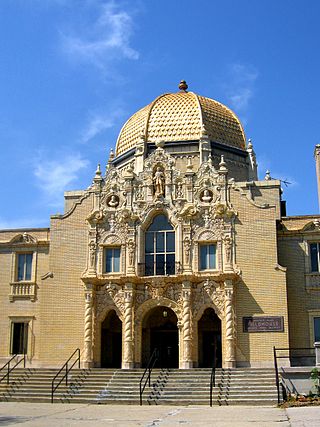
Magna is a city in Salt Lake County, Utah, United States. The current population of the city stands at 29,251 according to the 2020 census, a 10.4% increase over 26,505 in 2010.

Greektown in Vancouver, British Columbia, Canada is an area in the Kitsilano neighborhood that was historically an enclave of Greek immigrants and their descendants. The term is an informal one, and Greektown's borders are not strictly defined; however, West Broadway around Trutch Street is generally considered the neighbourhood's heart, while Blenheim St to the west and MacDonald St to the east are approximately its outer limits. Vancouverites of Greek descent, who live in Kitsilano, nostalgically also call the area Ουέστ Μπροντουέι.

The Near West Side, one of the 77 community areas of Chicago, is on the West Side, west of the Chicago River and adjacent to the Loop. The Great Chicago Fire of 1871 started on the Near West Side. Waves of immigration shaped the history of the Near West Side of Chicago, including the founding of Hull House, a prominent settlement house. The near west side comprises several neighborhoods. In the 19th century railroads became prominent features. In the mid-20th century, the area saw the development of freeways centered in the Jane Byrne Interchange.

The demographics of Chicago show that it is a very large, and ethnically and culturally diverse metropolis. It is the third largest city and metropolitan area in the United States by population. Chicago was home to over 2.7 million people in 2020, accounting for over 25% of the population in the Chicago metropolitan area, home to approximately 9.6 million.

Greektown is a social and dining district, located on the Near West Side of Chicago. Today, Greektown consists mostly of restaurants and businesses, although a cultural museum and an annual parade and festival still remain in the neighborhood.

Halsted Street is a major north-south street in the U.S. city of Chicago, Illinois.

The history of African Americans in Chicago or Black Chicagoans dates back to Jean Baptiste Point du Sable's trading activities in the 1780s. Du Sable, the city's founder, was Haitian of African and French descent. Fugitive slaves and freedmen established the city's first Black community in the 1840s. By the late 19th century, the first Black person had been elected to office.

Ukrainian Village is a Chicago neighborhood located on the near west side of Chicago. Its boundaries are Division Street to the north, Grand Avenue to the south, Western Avenue to the west, and Damen Avenue to the east. It is one of the neighborhoods in the West Town community area, and has one of the largest concentrations of Ukrainians in the United States, as the commercial and spiritual hub for nearly 70,000 Ukrainians in the greater Chicago region.
Various ethnic groups in Omaha, Nebraska have lived in the city since its organization by Anglo-Americans in 1854. Native Americans of various nations lived in the Omaha territory for centuries before European arrival, and some stayed in the area. The city was founded by white Anglo-Saxon Protestants from neighboring Council Bluffs, Iowa. However, since the first settlement, substantial immigration from all of Europe, migration by African Americans from the Deep South and various ethnic groups from the Eastern United States, and new waves of more recent immigrants from Mexico and Africa have added layers of complexity to the workforce, culture, religious and social fabric of the city.

Puerto Ricans in Chicago are individuals residing in Chicago with ancestral ties to the island of Puerto Rico. Over more than seventy years, they have made significant contributions to the economic, social, and cultural fabric of the city.

The National Hellenic Museum is the second oldest American institution dedicated to displaying and celebrating the cultural contributions of Greeks and Greek-Americans. Formerly known as the Hellenic Museum and Cultural Center, the National Hellenic Museum is located in Chicago’s Greektown, at the corner of Halsted and Van Buren Streets. The National Hellenic Museum has recently undergone a modernization program that cumulated in the museum moving to its current building in December 2011. The official opening of the NHM took place on December 10th, 2011 and proved to be a marked event within the Greek community of Chicago.
The mix of ethnic groups in Chicago has varied over the history of the city, resulting in a diverse community in the twenty-first century. The changes in the ethnicity of the population have reflected the history and mass America, as well as internal demographic changes. The groups have been important in the development of the city as well as players in occasional conflicts.
The history of Greeks in Baltimore dates back to the late 19th and early 20th centuries. Baltimore is home to one of the largest Greek American communities in the United States. The community is centered in the Greektown and Highlandtown neighborhoods of East Baltimore.
The Chicago metropolitan area has an ethnic Chinese population. While historically small in comparison to populations on the coasts, the community is rapidly expanding. As of 2023, there are 78,547 Chinese Americans who live in Chicago, comprising 2.9% of the city's population, along with over 150,000 Chinese in the greater Chicago area - making Chicago's Chinese community the 8th largest among US metropolitan areas. This population includes native-born Chinese as well as immigrants from Mainland China, Taiwan, Hong Kong and Southeast Asia, and also racially mixed Chinese.
As of the 2020 there were approximately 70,814 Korean-origin people in Illinois, with the vast majority in the Chicago metropolitan area. This makes Illinois the state with the eighth-largest Korean American population and the Chicago metropolitan area the fifth-largest, after Los Angeles, New York, Washington, and Seattle. As of 2006 the largest groups of Koreans are in Albany Park, North Park, West Ridge, and other communities near Albany Park. Many Koreans have since moved to northern and northwestern Chicago suburbs, including Glenview, Morton Grove, Mount Prospect, Niles, Northbrook, Schaumburg, and Skokie. A Koreatown, labeled "Seoul Drive", exists along Lawrence Avenue between Kedzie Avenue and Pulaski Road, albeit in diminished form. There were a number of Korean businesses on Clark Street in the 1970s, in Lakeview and Lincoln Park.
Chicago and its suburbs have a historical population of Italian Americans. As of 2000, about 500,000 in the Chicago area identified themselves as being Italian descent. As of 2023, this figure had increased to 573,170, making the Italian community in Chicagoland the 3rd largest in the US after New York and Philadelphia, and just slightly larger than that of Boston.

There is a very large Mexican American community in the Chicago metropolitan area. Illinois, and Chicago's Mexican American community is the largest outside of the Western United States.

The West Side is one of the three major sections of the city of Chicago, Illinois, United States. It is joined by the North and South Sides. The West Side contains communities that are of historical and cultural importance to the history and development of Chicago. On the flag of Chicago, the West Side is represented by the central white stripe.

The Greeks of Toronto comprises Greek immigrants and their descendants living in Toronto, Canada.













